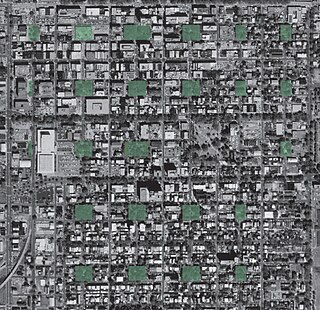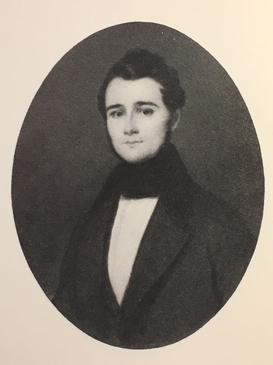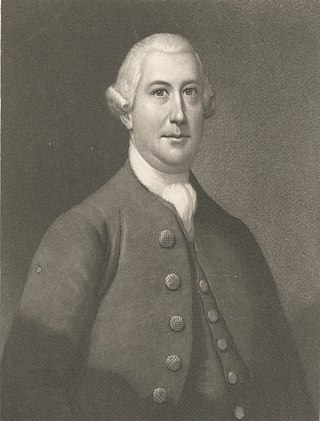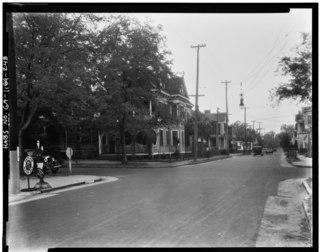
The city of Savannah, Province of Georgia, was laid out in 1733, in what was colonial America, around four open squares, each surrounded by four residential ("tything") blocks and four civic ("trust") blocks. The layout of a square and eight surrounding blocks was known as a "ward." The original plan was part of a larger regional plan that included gardens, farms, and "out-lying villages." Once the four wards were developed in the mid-1730s, two additional wards were laid. Oglethorpe's agrarian balance was abandoned after the Georgia Trustee period. Additional squares were added during the late 18th and 19th centuries, and by 1851 there were 24 squares in the city. In the 20th century, three of the squares were demolished or altered beyond recognition, leaving 21. In 2010, one of the three "lost" squares, Ellis, was reclaimed, bringing the total to today's 22.
The Savannah Historic District is a large urban U.S. historic district that roughly corresponds to the city limits of Savannah, Georgia, prior to the American Civil War. The area was declared a National Historic Landmark District in 1966, and is one of the largest districts of its kind in the United States. The district was made in recognition of the unique layout of the city, begun by James Oglethorpe at the city's founding and propagated for over a century of its growth.

The Olde Pink House is a restaurant and tavern in Savannah, Georgia, United States. Located on Abercorn Street, in the northwestern trust lot of Reynolds Square, the building dates from 1771. It is bounded by East Bryan Street to the north, Abercorn Street to the east and East Saint Julian Street to the south.

Columbia Square is one of the 22 squares of Savannah, Georgia, United States. It is located in the second row of the city's five rows of squares, on Habersham Street and East President Street. It is south of Warren Square and between Oglethorpe Square to the west and Greene Square to the east. The oldest building on the square is at 307 East President Street, today's 17 Hundred 90 Inn, which, as its name suggests, dates to the 18th century.

Reynolds Square is one of the 22 squares of Savannah, Georgia, United States. It is located in the northernmost row of the city's five rows of squares, on Abercorn Street and East St. Julian Street. It is east of Johnson Square, west of Warren Square and north of Oglethorpe Square. The oldest building on the square is The Olde Pink House, which dates to 1771.

Warren Square is one of the 22 squares of Savannah, Georgia, United States. It is located in the northernmost row of the city's five rows of squares, on Habersham Street and East St. Julian Street. It is east of Reynolds Square, west of Washington Square and north of Columbia Square. The oldest building on the square is the Spencer–Woodbridge House, at 22 Habersham Street, which dates to 1790. The Lincoln Street Parking Garage occupies the entire western side of the square.

Orleans Square is one of the 22 squares of Savannah, Georgia, United States. It is located in the middle row of the city's five rows of squares, on Barnard Street and West McDonough Street, and was laid out in 1815, shortly after the event it commemorates: General Andrew Jackson's victory at the Battle of New Orleans that January. It is south of Telfair Square, west of Chippewa Square and north of Pulaski Square. The oldest building on the square is the John Ash House, at 114–116 West Hull Street, which dates to 1817.

Troup Square is one of the 22 squares of Savannah, Georgia, United States. It is located in the fourth row of the city's five rows of squares, on Habersham Street and East Macon Street, and was laid out in 1837. It is south of Colonial Park Cemetery, east of Lafayette Square and north of Whitefield Square. The square is named for George Troup, the former Georgia governor, Congressman and senator. It is one of only two Savannah squares named for a person living at the time.

Whitefield Square is one of the 22 squares of Savannah, Georgia, United States. It is located in the southernmost row of the city's five rows of squares, on Habersham Street and East Wayne Street, and was the final square laid out, in 1851. It is south of Troup Square and east of Calhoun Square in the southeastern corner of Savannah's grid of squares. The oldest building on the square is at 412–414 East Taylor Street, which dates to 1855.

Kehoe House is a historic building in the American city of Savannah, Georgia. It is located in the northwestern civic block of Columbia Square and was built in 1892. It is part of the Savannah Historic District.

John Stoddard was an American businessman based in Savannah, Georgia, where he was a cotton merchant and planter. He was also president of the Georgia Historical Society from 1867 to 1868, having been its first vice-president between 1864 and 1867.

The Spencer–Woodbridge House is a home in Savannah, Georgia, United States. It is located in the northeastern civic block of Warren Square and was built in 1790, making it the oldest building on the square and one of the oldest in Savannah overall. It is part of the Savannah Historic District, and was built for George Basil Spencer, though he died in February 1791. It also became the homes of William H. Spencer until 1817 and William Woodbridge, who bought it from Spencer. It remained in the Woodbridge family until 1911.

Habersham Street is a prominent street in Savannah, Georgia, United States. Located between Lincoln Street to the west and Price Street to the east, it runs for about 4.82 miles (7.76 km) from East Bay Street in the north to Stephenson Avenue in the south. The street is named for merchant and statesman James Habersham. It was known as Prendergast Street in 1760. Its northern section passes through the Savannah Historic District, a National Historic Landmark District.

Lincoln Street is a prominent street in Savannah, Georgia, United States. Located between Abercorn Street to the west and Habersham Street to the east, it runs for about 2 miles (3.2 km) from East Bay Street in the north to East Victory Drive in the south. It is named for Benjamin Lincoln, a Revolutionary War hero. The street is one-way (northbound) south of Colonial Park Cemetery, which interrupts it between East Oglethorpe Avenue and East Perry Lane. The Lincoln Street Ramp leads down through Factors Walk to River Street and the Savannah River waterfront. Its northern section passes through the Savannah Historic District, a National Historic Landmark District.

Price Street is a prominent street in Savannah, Georgia, United States. Located between Habersham Street to the west and East Broad Street to the east, it runs for about 2.04 miles (3.28 km) from East Bay Street in the north to East Victory Drive in the south. The street's directional flow is one-way (southbound), with a single lane for motor vehicles and a dedicated lane for cyclists. Its northern section passes through the Savannah Historic District, a National Historic Landmark District.

Broughton Street is a prominent street in Savannah, Georgia, United States. Located between Congress Street to the north and State Street to the south, it runs for about 0.75 miles (1.21 km) from Martin Luther King Jr. Boulevard in the west to East Broad Street in the east. Originally known only as Broughton Street singular, its addresses are now split between "West Broughton Street" and "East Broughton Street", the transition occurring at Bull Street in the center of the downtown area. Broughton Street is named for Thomas Broughton, lieutenant-governor of South Carolina.

Perry Street is a prominent street in Savannah, Georgia, United States. Located between Hull Street to the north and Liberty Street to the south, it runs for about 0.46 miles (0.74 km) from Barnard Street in the west to East Broad Street in the east. It is interrupted by Colonial Park Cemetery from Abercorn Street to Habersham Street. Originally known only as Perry Street singular, its addresses are now split between "West Perry Street" and "East Perry Street", the transition occurring at Bull Street in the center of the downtown area. It is named for commodore Oliver Hazard Perry, who served in the War of 1812. The street is entirely within Savannah Historic District, a National Historic Landmark District.

The John Berrien House is a historic home in Savannah, Georgia, United States. It is located at 322–324 East Broughton Street, at its intersection with Habersham Street, and was built around 1794. One of the oldest extant buildings in Savannah, it is now part of the Savannah Historic District, and was built for major John Berrien, an army officer during the American Revolutionary War. Berrien lived in the house until 1797, when he moved to Louisville, Georgia. He sold the property to William Stephens, of Beaulieu Plantation. Stephens died in the home in 1882, at which point John Macpherson Berrien brought it back into the Berrien family. He lived there periodically until his death, also in the home, in 1856. Berrien's son-in-law Francis Bartow inherited the home, and he sold it to William Lake three years later.

The Hampton Lillibridge House is a historic home in Savannah, Georgia, United States. It is located at 507 East St. Julian Street, in the southwestern civic/trust lot of Washington Square, and was built around 1797. One of the oldest extant buildings in Savannah, it is now part of the Savannah Historic District. In a survey for the Historic Savannah Foundation, Mary Lane Morrison found the building, constructed by Rhode Island native Hampton Lillibridge, to be of significant status.

Cord Asendorf Sr. was a German–American businessman based in Savannah, Georgia. A prominent merchant, he is also noted for designing Savannah's "Gingerbread House", at today's 1921 Bull Street, in 1899.



















